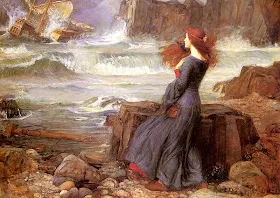Οι
καλύτερες εικόνες της Μιράντα που έχουμε μέχρι σήμερα μεταδόθηκαν από το Voyager 2 το 1986. A mosaic of high-resolution Voyager 2 images
of Miranda. One wide-angle and eight narrow-angle
camera images of Miranda were combined in this view. The controlled mosaic was
transformed to an orthographic view centered on the south pole. The trapezoidal
region (about 200 km on a side) occurs near the south pole and is located near
the center of the mosaic. The trapezoid's outer boundary and its internal
patterns of ridges and band of contrasting albedo display numerous sharp
corners. Credit: NASA/JPL
Φαράγγια
βάθους 20 χιλιομέτρων, πολυγωνικά οροπέδια που καταλήγουν σε απότομους
γκρεμούς. Το ασυνήθιστο τοπίο της Μιράντας, ενός από τα 27 φεγγάρια του πλανήτη
Ουρανού, πρέπει να οφείλεται σε παλιρροϊκές δυνάμεις που συμπίεζαν και τέντωναν
τον παγωμένο δορυφόρο.
Μυστηριώδης
Ο
δορυφόρος διαθέτει φαράγγια βάθους 20 χιλιομέτρων και πολυγωνικά οροπέδια. Miranda
reveals a complex geologic history in this view, acquired by Voyager 2 on 24
January 1986, around its close approach to the Uranian moon. At least three
terrain types of different age and geologic style are evident at this resolution
of about 700 m (2,300 feet). Visible in this clear-filter, narrow-angle image
are, from left: (1) an apparently ancient, cratered terrain consisting of
rolling, subdued hills and degraded medium-sized craters (2) a grooved terrain
with linear valleys and ridges developed at the expense of, or replacing, the
first terrain type: and (3) a complex terrain seen along the terminator, in
which intersecting curvilinear ridges and troughs are abruptly truncated by the
linear, grooved terrain. Voyager scientists believe this third terrain type is
intermediate in age between the first two. Credit: NASA/JPL
Οι
καλύτερες εικόνες που έχουμε από τη Μιράντα χρονολογούνται στο 1986, όταν η
αποστολή Voyager 2 πέρασε από το
δορυφόρο και πρόλαβε να φωτογραφίσει το νότιο ημισφαίριο. Ακόμα και σήμερα, κανείς
δεν γνωρίζει τι κρύβει το αθέατο βόρειο ημισφαίριο.
Τα
διαθέσιμα στοιχεία δείχνουν ότι η επιφάνεια του φεγγαριού πρέπει να άλλαξε
δραστικά σε κάποια φάση της εξέλιξής του. Αυτό που διακρίνεται σήμερα στο νότιο
ημισφαίριο είναι πολυγωνικοί σχηματισμοί που ονομάζονται «κορόνες». Η
μεγαλύτερη από αυτές, η κορόνα Arden,
έχει πλάτος 200 χιλιομέτρων με μεγάλους γκρεμούς και κορυφογραμμές ύψους δύο
χιλιομέτρων.
Οι
παλίρροιες
Ποια
διαδικασία μπορεί να οδήγησε στην εμφάνιση αυτών των παράξενων σχηματισμών. Χρησιμοποιώντας
μαθηματικά μοντέλα, ερευνητές της Εταιρείας Γεωλογίας των ΗΠΑ κατέληξαν σε μια
πιθανή απάντηση.
Το
πιθανότερο, αναφέρουν οι ερευνητές στην επιθεώρηση «Geology», είναι ότι ολόκληρη η Μιράντα
παραμορφώθηκε λόγω των παλιρροϊκών δυνάμεων που ασκούσε η βαρυτική έλξη του
Ουρανού. Ο δορυφόρος κινούνταν κάποτε σε μια άκρως ελλειπτική τροχιά, στην
οποία η απόσταση του δορυφόρου από τον μητρικό του πλανήτη διαρκώς
αυξομειωνόταν.
Αυτό
συνοδευόταν από σχετικά απότομες αυξομειώσεις της έλξης που ασκεί ο Ουρανός στο
φεγγάρι του. Λόγω των αυξομειώσεων αυτών, ολόκληρος ο δορυφόρος περιοδικά
συμπιεζόταν και μετά τεντωνόταν. Οι εσωτερικές αυτές παλίρροιες απελευθέρωναν
τεράστιες ποσότητες θερμότητας λόγω της τριβής ανάμεσα στα πετρώματα. Η
θερμότητα πιθανότατα δημιούργησε στρώματα θερμού, ελαφρότερου πάγου μέσα στον
παγωμένο μανδύα, τα οποία ανέβηκαν προς την επιφάνεια και παραμόρφωσαν το
φλοιό.
John William
Waterhouse (1849-1917), Miranda - The Tempest, 1916.
Σύμφωνα
με τους ερευνητές, η θεωρία της παλιρροϊκής παραμόρφωσης εξηγεί όχι μόνο το
σχηματισμό των κορονών αλλά και τις θέσεις στις οποίες βλέπουμε αυτούς τους
σχηματισμούς σήμερα. Η Μιράντα κινείται πλέον σε μια πιο κυκλική τροχιά και η
παραμόρφωση πιθανότατα έχει σταματήσει. Το φεγγάρι παίρνει το όνομα της κόρης
του Πρόσπερου από το έργο «Η Τρικυμία»
του Ουίλιαμ Σαίξπηρ. Και οι 27 γνωστοί δορυφόροι του Ουρανού παίρνουν ονόματα
από έργα του Σαίξπηρ και του άγγλου ποιητή του 18ου αιώνα Αλεξάντερ Πόουπ.









